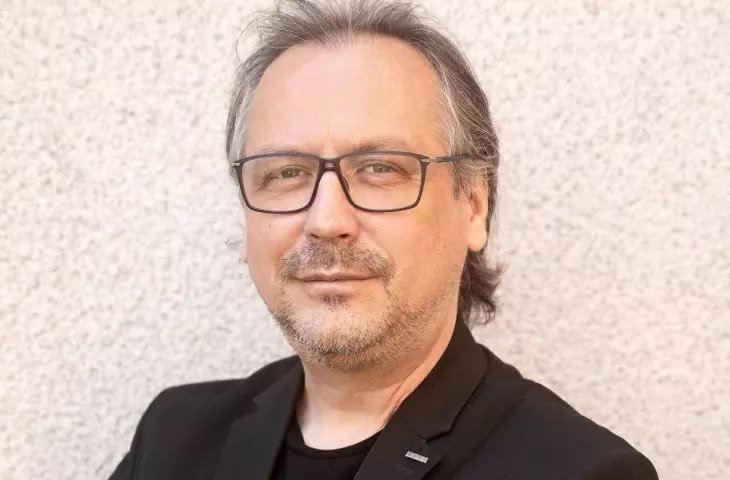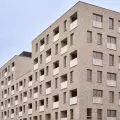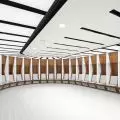In recent months, local SARP branches held elections for new authorities for the 2024-2028 term [RESULTS]. We take a closer look at the plans of the newly elected presidents of the Society of Polish Architects, and we ask those who were re-elected to summarize the past years. We also ask them why it's worth belonging to SARP and about contemporary challenges facing architects and female architects. Today Jakub Krzysztofik, president of the SARP branch in Łódź, answered our questions.
SARP Branch Łódź
Ola Kloc: How would you summarize the past term?
Jakub Krzysztofik: My assessment must be based on the position of the program I presented at the election meeting in 2019, which was successfully implemented and evaluated by the members at the election in 2024 (unanimous approval). When I took over as president, our environment was in a serious crisis, but after 3 years of hard work we managed to overcome it. Among the basic achievements is the rebuilding of SARP Łódź's image as an efficient and agile organization. We organized many substantive meetings, discussions and workshops. We have overcome mutual distrust and established relationships with the authorities of Lodz, but also other cities in the province.
Meetings and discussions are held under the brand #SalonMiejski (led by Lech Grabski, Karolina Taczalska), and workshops on prototyping streets and urban spaces are called #Od-New (the project is led by Karolina Taczalska and Mateusz Cyganek). We successfully run the Weduta school of architectural drawing at our headquarters (led by Dr. Krzysztof Ułamek) and organize a competition for the best SARP Engineering Diploma of the Year (led by Dr. Wojciech Pardała). We do this in cooperation with the Scientific Circle IX Floor from the Technical University of Lodz. In this way, we establish contact with young people interested in architecture, students and the academic community. The Young Architects Section of our branch was established, which is part of the SARP U40 environment (headed by Mateusz Cyganek). In addition, experienced SARP Łódź architects are lecturers at the School of Art and Design (SARP has a cooperation agreement with the university). We have obtained patronage for our student competitions from the Mayor of Łódź and the Architect of the City. We are working on finalizing two competitions for museum objects. We also have many dedicated partners from the community of construction companies and building material manufacturers who support us organizationally and financially. We also actively participate in national architectural events, sharing our experience in revitalization and social work with intellectual and social circles from Krakow, Rzeszow, Kielce, Szczecin and Katowice, among others. We regularly publish articles in the trade press.
To sum up, we still have a lot of work ahead of us, but we are visible in the architectural discourse in the province and the country, we have contact with key opinion-making media, and we are working hard for the image of an environment active in the sphere of urban transformation and sensitive to the social elements of local government policy.
Ola Kloc: What program of activities of the SARP branch do you assume for the near future? Are there any changes planned?
Jakub Krzysztofik: After the organizational and financial and image reconstruction of our branch in the previous term, it is time for a more collegial vision of work and integration of our environment. We are working on a new program, which is no longer the author's vision of the president, but of the entire board, and each member of the board presented his own program element at the election meeting. Now we want to set priorities and arrange the action items in time.
We managed to bring in new, valuable and excellent architects to the authorities of SARP Łódź. The current composition of the board is a completely new group, consisting of Piotr Piasecki (1st vice-president in charge of moderating urban policy and relations with IARP and TUP), vice-president Karolina Taczalska (academic lecturer, initiator of the #Od-New urban space prototyping project, architectural educator), vice president for creativity Dr. Wojciech Pardała (scientist and lecturer, responsible for competitions, contacts with the academic and student community), secretary Barbara Pluskota-Gajewska (academic lecturer, responsible for organizational matters of the branch and for the promotion of inclusive design), treasurer Wiktor Wróblewski, Ph. D. (academic and lecturer, will be responsible for the branch's finances and urban policy issues, as well as conditions of practice), Magdalena Rafałowicz (academic lecturer, organizing the interior design community within SARP, also responsible for contacts with partners), Dr. Lech Grabski (scientist, CPTED specialist, promoter of an innovative way of designing to discourage socially undesirable behavior), Mateusz Cyganek (lecturer, head of the Young Section, which also has the task of taking care of us SARP seniors), Michal Koziej (expert on sustainable architecture). The pillar, mentor and advisor of our board is SARP Łódź senior president Andrzej Owczarek, who heads the College of Competition Judges. There are also many people willing to cooperate with the branch's authorities, who will contribute to the work of the newly organized substantive teams during the term and as we develop our program in accordance with the motto: #SARPisAPlaceForAll.
My personal goal is to create an Architectural Sketch Gallery, and we are in talks to have Daniel Libeskind's sketch be the gallery's first depository.
Ola Kloc: What are the biggest challenges facing architects today?
Jakub Krzysztofik: This is an extremely difficult but pertinent question and the most important one that our environment has to face. I will answer this question in three problem categories, at the same time I will try to outline the directions in which we should look for solutions. We need to face the facts and define the challenges we face.
First and foremost is the low and steadily declining prestige of our profession. This process has its own internal and external causes. Nowadays, the demands on the profession are constantly increasing (growing civil and material liability), the need to adapt to legal changes, including the requirements of digitizing the construction process. At the same time, investors and contractors are trying to lower the role and influence on the investment of architects, using permitted and unauthorized methods. On the other hand, architects, who are atomized and distrustful of each other and the organizations that associate them, do not stand a chance on their own and bow to this pressure, feeling increasingly disappointed with the results of their work.
The second challenge is low wages for both architectural firms and their employees. Private investors, especially developers, do not see the link between the quality of architects' services and the profits they make. They don't want to share their huge margins, although this would often translate into even higher financial profits for them, but above all prestige and social effects, which are also financially measurable. In the public procurement market, on the other hand, there is a devastating battle between design offices in tenders where price is the dominant selection criterion. Contracting authorities, although they can, are afraid to venture into increasing the role of qualitative selection criteria, rather than just price.
Such a situation exacerbates internal conflicts among architects: young people with aspirations perceive experienced architects as those who block their development and concretize the market with their acquaintances and the advantage of seniority. In turn, architects-employers are not satisfied with the technical and professional preparation of their young employees, which they take from the university, for the profession and their financial aspirations.
The third cause of the crisis and, in my opinion, the most important, is the poor mental condition of all groups of architects: starting with students, young architects, heads of small and large design offices, but also lecturers or officials. In academia, pathological behavior thrives on the lecturer-student line, resulting from overworked academics, but also from their undervaluation, because in devoting themselves to their work at the university (fraught with monstrous bureaucracy), they have to give up their professional work, which undermines their credibility as mentors to young people. This sacrifice does not go hand in hand with good salaries and translates directly into a lack of authority with students and poor teacher-student relations. Under such conditions of tension and stress, it is not difficult to create conflict and undesirable situations. Students have the unpleasant realization that they are learning unnecessary things, have no contact with practicing lecturers who are not interested in working at the university, and even if they want to, they arouse the envy of university theoreticians and are blocked. The same is true among civil servants and ordinary architects. Overwork, poor organization and hygiene, lack of time for further education, study trips, reading books or magazines. Instead, they try to solve problems with purchases on a whim in the form of luxury cars, foreign trips or show homes to impress their friends, even though it's obvious they can't afford them. This all stems from the myth of the architect as a successful, wealthy man, driving an expensive four-wheel-drive car and owning a beautiful designer home. The truth is that these possessions are often bought on credit and for show and can be afforded by a truly few. The family life, health, well-being of most architects is in a deplorable state.
All three of these reasons add up to a widespread low self-esteem among architects, which, combined with long-term stress, translates into health problems for the entire embryonic group, and these are most often no longer heart attacks or cancer, but depression, which, often ignored, translates into the breakdown of family life and inevitable disaster in professional practice.
How can this be remedied? Unfortunately, I don't have a magic wand and simple advice on how to deal with all this. Nor do I intend to lecture anyone or give advice in a mentor-like tone. I can only say in general that we need to seriously reflect on the situation, subject our professional and private lives to thorough reflection and analysis. Maybe then it would be possible to work through these topics and outline a direction for change. Solving these problems is not simple and easy, because they themselves stem from the extremely complex challenges of today's atomized society, of which we are a part as a professional group. However, I see a basic condition: it is worth being together and facing the problems together. Define problems and look for tools to solve them. It doesn't matter to me whether this happens within SARP, TUP or the Chamber of Architects, or maybe some other organization. What is important is to build a community that is able to define the essence of the substance that binds it together and the problem we want to solve together.
This is already half the battle, which, to achieve, you need to have a program and implement it with iron consistency. Let's face it, the economic sector we are dealing with generates huge turnover and profits. Therefore, it is possible to earn decently without breaking one's own beliefs and principles. The question is how? This market consists of two main areas: public procurement and the development market. The view of our environment is to link the quality of projects (including increased remuneration) with the direct benefits of the procurer. In the case of public procurements, these are: low operating costs, conformity of the order with real needs and high social acceptance of the architecture that is created. In the case of private investments, it is worthwhile for architects to try to link remuneration to the economic effect of the investment and negotiate a bonus, but payable upon completion. In my experience, it is relatively easy to negotiate a bonus depending on the profit and success of the investment at an early stage of the project. If we share the risk and hardship with the investor in solidarity throughout the construction until the final acceptance, then it is a matter of formal implementation of mutual obligations to collect the reward (preferably in the form of buying at manufacturing costs a part of the residential space that our own design ingenuity has additionally obtained). This is my advice (I know it's not easy) to architects who care a lot about the economic results of their work.
Looking more broadly, I am convinced that modern architects should abandon the claiming vision that they are entitled to some privileges, high salaries or prestige. You have to earn these things solidly, and no one will give it to us without a fight and real coercion. I see a chance for change in the opening of architects to social problems. To begin with, we should not be so focused on ourselves and our own problems, because all social groups have similar problems. Sensitivity to other people should be the most important feature of the silhouette of today's architect. In terms of education — it is not necessary to change any law to improve the system of education of architects in Poland, but it is necessary to rebuild priorities in each of the subjects taught: emphasize erudition, humanities subjects (philosophy, sociology and psychology). The university should give the basics of social competence: consultation, negotiation and dialogue with investment stakeholders, not just the investor. In business matters, it is important to acquire economic and management competencies: how to run a company, how to promote and develop it. The most important thing, in my opinion, is to say goodbye to harmful myths: that you need to work more than a dozen hours a day and on weekends, sleep at night, make a career at a young age, drive a luxury car and have a big designer house with a pool. This is an easy road to career burnout, depression, family breakdown and loss of physical health. It's not worth putting off the decision to start a family and have children for the sake of a career. "Architecture is not ballet", Prof. Boleslaw Kardaszewski told us at lectures, and you don't have to make a career right away before your 30s or 40s. There is time for everything. Instead of resenting, as a professional group, everyone, let's start with ourselves. In my opinion, it is possible to achieve prestige and image goals in parallel with a good salary. This can be done by working 8 hours a day, without working weekends and not at the expense of family life. I believe that these are the environmental goals we should set for ourselves and share the experience of how to achieve them. It is also worth revising the stereotypes we are subjected to. There is nothing shameful in the fact that an architect drives a used or several-year-old car, lives in a tenement or in a block of flats. Or he gets around by public transportation or bicycle. Is it appropriate today to show up in expensive designer clothes at banquets? Or is it better to take a risk and say that I dress in secondhand stores and buy on sale? This way I take care of the climate. Instead of taking out loans for a luxury house, car and exotic vacations, it's worth investing in yourself, improving your competence, thinking well about your professional and life path, setting priorities and spreading them out over time. Live more modestly and simply. The Danes call it hygge.
From my observations, most students go through college without having read a single book on architecture. I constantly see architects complaining about their professional situation, although they have long since stopped reading anything and developing themselves, they run their firms without any managerial preparation, plunging into chaos and improvisation. Rare are the heads of architectural firms who have at least framework strategic documents in their business: a vision and mission of the company, short- and long-term goals and, most importantly, have a financial reserve to survive a difficult moment and then have a negotiating advantage over the client.
In conclusion, our environment requires deep reflection and debate on the role of the architect in society, work on rebuilding the image, opening up to society, intelligent reform of the way of education and a concrete vision of the professional start and stages of development for young architects. It is worth fighting for qualitative criteria in public proceedings and strengthening the role of the architect in private procurement (by linking remuneration to financial effect). This, I think, is what we should be concerned with in organizations of architects.
Ola Kloc: What does SARP give to architects today? Why is it worth being a member of the Association?
Jakub Krzysztofik: In principle, I already answered in the previous question, pointing out specific barriers, but also solutions and directions for the development of our environment. But I will repeat in the form of a reflexive conclusion: only together are we able to change something, although we need to take into account the enormous diversity of the architectural community, including geographically. I am sorry to remind you of this, but it is worthwhile to work socially, share experience and help others. It is worthwhile to resist the social processes of social disintegration, Internet storms and unfair criticism. It's worth working on yourself without looking for fault in others. It's worth suppressing narcissistic traits, pride, selfishness in oneself and opening one's eyes to other architects and members of society. It's worth admitting mistakes and failures sometimes, but you also need to know how to celebrate small and big successes. It is worthwhile to distinguish between the things that are beyond our control and those that we can change and focus on them in action. It's worth rejecting false role models and authorities, trivialities and illusory goals. It's worth opening our eyes and seeing the world outside the Internet bubble, the marketplace of stupidity and vanity in which our architectural community, and society more broadly, is stuck.
This is how I see the sense of the social press in the Association. This is how I would like to see SARP. This is #SARPOfmyDreams. For this to happen, our Association must undergo a profound image, organizational and property reform. Then we will truly address the creativity and position of the architect in society. A position that is servile, but also respected. Even if this is an idealistic vision, it is worth devoting time and effort to fight for such goals and to stop the processes of social disintegration. Architecture, unlike many other fields, is sustainable, and architects will leave their mark.
However, I fear that without radical and consistent reform we will not be able to cope with this challenge, and the Association will gradually be marginalized and lose its influence on architectural discourse. I can as a memento once again quote my master and educator Prof. Boleslaw Kadaszewski:
Architecture is the meaning of my life, so I persist. And I keep hoping that maybe the next project will be better done, will not be the result of a thousand resignations and compromises, that maybe next time it will work out. Maybe my children's children will live to see the moment when we will not waste people's passions, qualifications, efforts. Because I no longer have the strength to wait.
Ola Kloc: How many members are there in the branch and how much are the dues?
Jakub Krzysztofik: This is a rather funny question and I won't answer it by directly quoting my colleague and friend Mark Kaszynski:
It doesn't matter how many members you have in the branch or the board. And so only 2-3 people work.
And so seriously we have 172 members, the fee is 20 zloty per month. Let's prepare a reform of membership in our branch and we will verify all members for their real willingness as to membership and action. I am in the fortunate position that after hard organizational work and rebuilding of our Lodz environment, we are seen as one of the most active branches in the country. To be more specific, there are about 15-20 very committed members, most of whom are active in SARP's statutory bodies (board, competitions, debates, sections). There is also a group of about 20-30 people who occasionally join in organizational work or passively participate in meetings and events. We also have a group of loyal supporters who have no time or aspirations for any activity, but support us by paying dues, kind advice or a good word. We also have a bunch of virulent critics and haters who, with their pithy actions, reassure our board that we are moving in the right direction and doing a good job. I heartily salute them!














